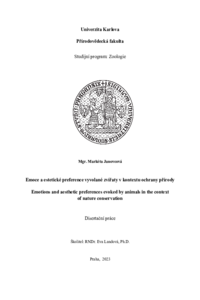Emoce a estetické preference vyvolané zvířaty v kontextu ochrany přírody
Emotions and aesthetic preferences evoked by animals in the context of nature conservation
dizertační práce (OBHÁJENO)

Zobrazit/
Trvalý odkaz
http://hdl.handle.net/20.500.11956/187466Identifikátory
SIS: 170343
Kolekce
- Kvalifikační práce [21483]
Autor
Vedoucí práce
Konzultant práce
Frynta, Daniel
Oponent práce
Stibral, Karel
Prokop, Pavol
Fakulta / součást
Přírodovědecká fakulta
Obor
Zoologie
Katedra / ústav / klinika
Katedra zoologie
Datum obhajoby
19. 12. 2023
Nakladatel
Univerzita Karlova, Přírodovědecká fakultaJazyk
Čeština
Známka
Prospěl/a
Klíčová slova (česky)
emoce, krása, plazi, ohrožené druhyKlíčová slova (anglicky)
emotion, beauty, reptiles, endangered speciesLidé vždy vnímali zvířata jako důležitou součást svého života. Vlivem lidské činnosti a dalších faktorů stále přibývá druhů, které jsou ohrožené. V poslední době získává na významu ochrana přírody, ochranářské aktivity se ovšem neobejdou bez podpory veřejnosti, nejen finanční. Z tohoto důvodu je nutné pochopit, jak lidé zvířata vnímají a jaké důsledky to může mít pro plánování záchranných programů. V této práci jsme se zaměřili na pozitivní vnímání zvířat zjišťované pomocí estetických preferencí (krásy zvířete) a negativní vnímaní skrze emoce (strach a znechucení). Bylo zjištěno, že pro podporu ochranářských aktivit u preferované skupiny savců, má rozhodující vliv krása zvířete a přisuzovaná nebezpečnost, naopak velikost těla a přisuzovaná inteligence vliv nemají. Oproti tomu plazi představují často opomíjenou skupinu obratlovců, přesto jsou lidmi vnímáni poměrně konzistentně. Lidé plazy rozlišují na základě vnějšího vzhledu, a to podle přítomnosti končetin. Vzniká zde tedy samostatná skupina beznohých plazů reprezentovaná zejména hady a beznohými ještěry (např. dvouplazi, Amphisbaenia), u kterých platí vlastní pravidla pro hodnocení krásy i emocí. Jak bylo zjištěno v následujících studiích, hadi netvoří v lidských očích jednu homogenní skupinu, najdeme zde taxony, které vyvolávají zejména strach...
People have always seen animals as an important part of their lives. As a result of human activity and other factors, an increasing number of species are becoming endangered. Recently, nature conservation has become increasingly important, but conservation activities cannot do without public support, not only financial. For this reason, it is necessary to understand how people perceive animals and what implications this may have for planning conservation programmes. In this paper, we focused on positive perceptions of animals ascertained through aesthetic preferences (the beauty of the animal) and negative perception through emotions (fear and disgust). It was found that the beauty of the animal and attributed dangerousness have a decisive influence on the support of conservation activities in the preferred group of mammals, while body size and attributed intelligence do not. In contrast, reptiles are an often neglected group of vertebrates, yet they are perceived by humans quite consistently. Humans distinguish reptiles on the basis of external appearance, namely the presence of limbs. Thus, there is a separate group of legless reptiles represented mainly by snakes and legless lizards (e.g. Amphisbaenia), which have their own rules for evaluating beauty and emotions. As it was found in the...
